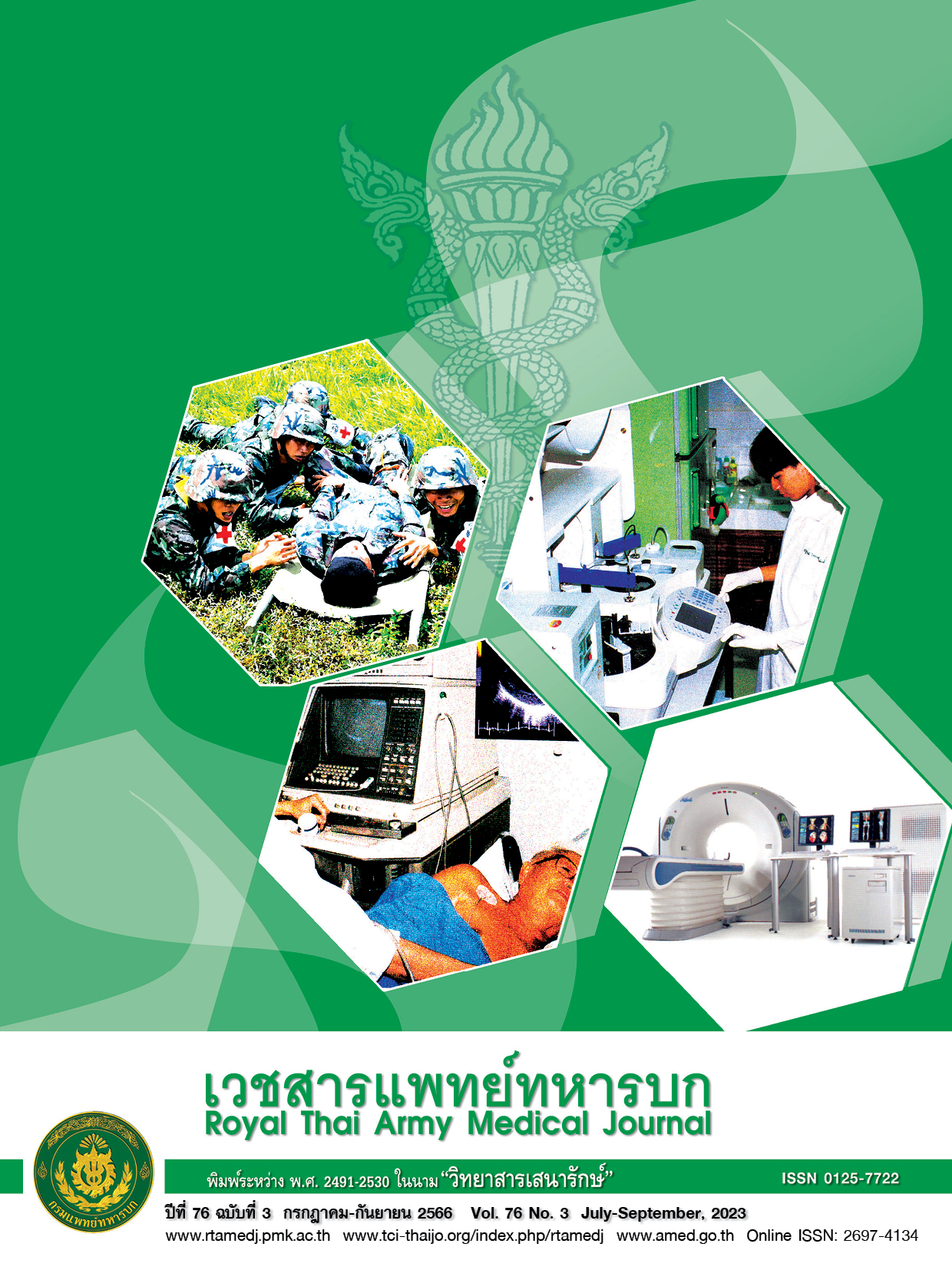ประสิทธิผลของการใช้ Sternocleidomastoid muscle flap ต่อการป้องกันภาวะรูรั่วที่คอหอยหลังผ่าตัดกล่องเสียงออกทั้งหมด : การศึกษาแบบกรณีควบคุมในอนาคต
Main Article Content
บทคัดย่อ
บทนำ Total laryngectomy เป็นการผ่าตัดที่ซับซ้อนและมีความยากในการเอากล่องเสียงออกทั้งหมด ซึ่งมักทำเพื่อรักษามะเร็งกล่องเสียง หนึ่งในปัญหาที่อาจเกิดขึ้นหลังการผ่าตัดคือ ภาวะรูรั่วที่คอหอยหลังผ่าตัดกล่องเสียงออกทั้งหมด ซึ่งเป็นการเชื่อมต่อที่ผิดปกติ ระหว่างแผลเย็บที่คอหอยกับผิวหนังบริเวณคอ ภาวะรูรั่วนี้มีผลกระทบอย่างมากต่อสุขภาพของผู้ป่วยระยะเวลานอนโรงพยาบาล และค่าใช้จ่ายในการดูแลสุขภาพ การใช้ SCM flap เป็นเทคนิคที่มีประสิทธิภาพในการป้องกันภาวะรูรั่วที่คอหอยหลังผ่าตัดกล่องเสียงออกทั้งหมด โดยช่วยส่งเสริมการฟื้นตัวและลดภาวะแทรกซ้อน วัตถุประสงค์ การศึกษานี้มีวัตถุประสงค์เพื่อเปรียบเทียบประสิทธิผลการใช้ SCM flap ในการป้องกันภาวะรูรั่วที่คอหอยหลังผ่าตัดกล่องเสียงออกทั้งหมดในผู้ป่วยที่ยังไม่ได้ฉายรังสี วิธีการศึกษา การทดลอง คลินิกแบบ Open-Label โดยมีผู้ป่วยที่ทำการผ่าตัดกล่องเสียงออกทั้งหมดจำนวน 16 ราย และแบ่งเป็น 2 กลุ่ม กลุ่มควบคุมซึ่งทำการ ผ่าตัดปิดช่องคอโดยวิธีมาตรฐาน และกลุ่มศึกษาซึ่งทำการเสริมกล้ามเนื้อสเตอร์โนไคโดมาสตอยด์บริเวณแผลเย็บจากนั้นเปรียบเทียบผลลัพธ์ระหว่างกลุ่มทั้งสอง ผลการศึกษา ไม่มีผู้ป่วยในกลุ่มควบคุมที่พบภาวะรูรั่วที่คอหอยหลังผ่าตัดกล่องเสียงออกทั้งหมด ขณะที่ผู้ป่วย 2 รายในกลุ่มที่ใช้ SCM flap พบภาวะรูรั่วที่คอหอยหลังผ่าตัดกล่องเสียงออกทั้งหมด อย่างไรก็ตามทั้งสองกลุ่มไม่แตกต่างกันอย่างมีนัยสำคัญทางสถิติ (p = 0.466) เช่นเดียวกับระยะเวลานอนโรงพยาบาล แม้ว่าการศึกษาของเราจะไม่พบความแตกต่างที่สำคัญ ในการเกิดภาวะรูรั่วที่คอหอยหลังผ่าตัดกล่องเสียงออกทั้งหมด การใช้ SCM flap ยังมีประโยชน์ในการฟื้นตัวและลดภาวะแทรกซ้อนของ donor site ควรมีการศึกษาเพิ่มเติมที่ใช้ขนาดตัวอย่างมากขึ้นและวิธีการเขิงลึกเพื่อประเมินประสิทธิผลของการใช้ SCM flap ในการป้องกันภาวะรูรั่วที่คอหอยหลังผ่าตัดกล่องเสียงออกทั้งหมด สรุป ภาวะรูรั่วที่คอหอยเป็นภาวะแทรกซ้อนที่ท้าทายหลังผ่าตัดกล่องเสียงออกทั้งหมด การศึกษาของเราพบว่าไม่มีความแตกต่างที่สำคัญในการเกิดภาวะรูรั่วที่คอหอยก่อนได้รับการฉายรังสี ระหว่างกลุ่ม SCM flap และกลุ่มควบคุม
Downloads
Article Details

อนุญาตภายใต้เงื่อนไข Creative Commons Attribution-NonCommercial-NoDerivatives 4.0 International License.
บทความในวารสารนี้อยู่ภายใต้ลิขสิทธิ์ของ กรมแพทย์ทหารบก และเผยแพร่ภายใต้สัญญาอนุญาต Creative Commons Attribution-NonCommercial-NoDerivatives 4.0 International (CC BY-NC-ND 4.0)
ท่านสามารถอ่านและใช้งานเพื่อวัตถุประสงค์ทางการศึกษา และทางวิชาการ เช่น การสอน การวิจัย หรือการอ้างอิง โดยต้องให้เครดิตอย่างเหมาะสมแก่ผู้เขียนและวารสาร
ห้ามใช้หรือแก้ไขบทความโดยไม่ได้รับอนุญาต
ข้อความที่ปรากฏในบทความเป็นความคิดเห็นของผู้เขียนเท่านั้น
ผู้เขียนเป็นผู้รับผิดชอบต่อเนื้อหาและความถูกต้องของบทความของตนอย่างเต็มที่
การนำบทความไปเผยแพร่ซ้ำในรูปแบบสาธารณะอื่นใด ต้องได้รับอนุญาตจากวารสาร
เอกสารอ้างอิง
Wang M, Xun Y, Wang K, Lu L, Yu A, Guan B, et al. Risk factors of pharyngocutaneous fistula after total laryngectomy: a systematic review and meta-analysis. Eur Arch Otorhinolaryngol. 2020;277(2):585-99.
Dedivitis RA, Ribeiro KC, Castro MA, Nascimento PC. Pharyngocutaneous fistula following total laryngectomy. Acta Otorhinolaryngol Ital. 2007;27(1):2-5.
Virtaniemi JA, Kumpulainen EJ, Hirvikoski PP, Johansson RT, Kosma VM. The incidence and etiology of postlaryngectomy pharyngocutaneous fistulae. Head Neck. 2001;23(1):29-33.
White HN, Golden B, Sweeny L, Carroll WR, Magnuson JS, Rosenthal EL. Assessment and incidence of salivary leak following laryngectomy. Laryngoscope. 2012;122(8):1796-9.
Krouse JH, Metson R. Barium swallow is a predictor of salivary fistula following laryngectomy. Otolaryngol Head Neck Surg. 1992;106(3):254-7.
Lecle`re FM, Vacher C, Benchaa T. Blood supply to the human sternocleidomastoid muscle and its clinical implications for mandible reconstruction. Laryngoscope. 2012;122(11):2402-6.
Khazaeni K, Rajati M, Shahabi A, Mashhadi L. Use of a sternocleidomastoid myocutaneous flap based on the sternocleidomastoid branch of the superior thyroid artery to reconstruct extensive cheek defects. Aesthetic Plast Surg. 2013;37(6):1167-70.
Chen HC, Chang HS. The Sternocleidomastoid Flap for Oral Cavity Reconstruction: Extended Indications and Technical Modifications. J Oral Maxillofac Surg. 2015;73(12):2429-39.
Albirmawy OA. Prevention of post laryngectomy pharyngocutaneous fistula using a sterno cleidomastoid muscle collar flap. J Laryngol Otol. 2007;121(3):253-7.
Naghibzadeh M, Zojaji R, Mokhtari Amir Majdi N, Mazloum Farsi Baf M. Using a sternocleidomastoid muscle flap to prevent postoperative pharyngocutaneous fistula after total laryngectomy: a study of 88 cases. Ear Nose Throat J. 2014;93(8):362-5.
Ibrahim SG, Wahba BM, Elbatawi AM, Eltelety AM. Sternocleidomastoid flap augmentation of the pharyngeal closure after total laryngectomy. Eurr Arch Otorhinolaryngol. 2017;274(8):3197-202.
Suzuki S, Yasunaga H, Matsui H, Horiguchi H, Fushimi K, Yamasoba T. Pharyngocutaneous fistula and delay in free oral feeding after pharyngolaryngectomy for hypopharyngeal cancer. Head Neck. 2016;38(Suppl 1):E625-30.
Singer MI, Blom ED. Selective myotomy for voice restoration after total laryngectomy. Arch Otolaryngol. 1981;107(11):670-3.
Timmermans AJ, Lansaat L, Theunissen EA, Hamming-Vrieze O, Hilgers FJ, van den Brekel MW. Predictive factors for pharyngocutaneous fistulization after total laryngectomy. Ann Otol Rhinol Laryngol. 2014;123(3):153-61.
Galli J, De Corso E, Volante M, Almadori G, Paludetti G. Postlaryngectomy pharyngocutaneous fistula: incidence, predisposing factors, and therapy. Otolaryngol Head Neck Surg. 2005;133(5):689-94.
Sumarroca A, Rodríguez-Bauzà E, Lop-Gros J, García J, López M, Quer M, et al. Repair of post-laryngectomy pharyngocutaneous fistulas using a pectoralis major flap. Braz J Otorhinolaryngol. 2019;85(3):351-6.
Guimarães AV, Aires FT, Dedivitis RA, Kulcsar MA, Ramos DM, Cernea CR, et al. Efficacy of pectoralis major muscle flap for pharyngocutaneous fistula prevent salvage total laryngec tomy: A systematic review. Head Neck. 2016;38(Suppl 1):E2317-21.
Sharma S, Chaukar DA, Laskar SG, Kapre N, Deshmukh A, Pai P, et al. Role of the pectoralis major myofascial flap in preventing pharyngocutaneous fistula following salvage laryngectomy. J Laryngol Otol. 2016;130(9):860-4.
Cömert E, Tunçel Ü, Torun MT, Kiliç C, Cengiz AB, Sencan Z, et al. Pectoralis major myofascial flap in salvage laryngectomy. J Laryngol Otol. 2014;128(8):714-9.
Shah JP, Haribhakti V, Loree TR, Sutaria P. Complications of the pectoralis major myocutaneous flap in head and neck reconstruction. Am J Surg. 1990;160(4):352-5.


